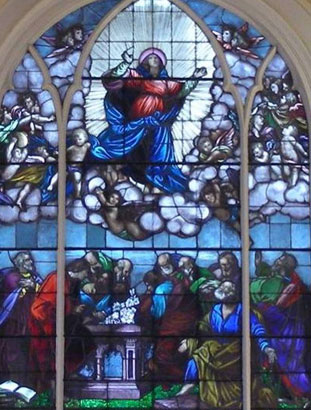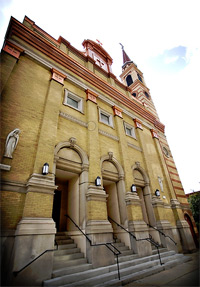About the same time, a woman was knocked down by a team of horses pulling a hired carette in front of Marshall Field’s on State Street. A bystander, afraid the woman was badly hurt, took hold of the team to hold them until the police could arrive. The conductor of the carette, objecting to being detained, struck the man with his ticket register, inflicting a severe scalp injury. A policeman had arrived in time to witness all this, but while he was arresting the conductor, the woman who had been knocked down got up and slipped away.
 |
| Auditorium Building, Chicago. Public Domain. |
Despite the cold snap, this Christmas season had set sales records across the country. All the passenger trains entering Chicago on Christmas Eve were late by up to three hours due to the large volume of express packages being handled by all the railroad lines. The express business more than the cold weather had been more responsible for delays this season. “People talk about hard times,” stated an express office clerk, “but I don’t see where it comes in with all this rush of business. Christmas trade is nearly all in luxuries, or at least things people don’t have to have, and here you see such an amount of it that it is blocking traffic all over the country. People don’t know when they are well off.” The mail too was overburdened by this unprecedented rush. This Christmas many packages would be delivered late.
In addition to stories of the heavy Christmas trade, the newspapers would report on events occurring throughout the city. The Tribune reported on the services to be held Christmas Day in the churches, complete with programs. That day, the Solemn High Mass at the Church of the Ascension on La Salle Avenue and Elm Street included music by Handel and Schubert, Mozart’s “Twelfth Mass,” and carols including “O, Come All Ye Faithful” and “Hark, the Herald Angels Sing.” Interspersed with this more modern music were reminders of the Church’s medieval past heard in the Gregorian chants and plainsong. There were also reports of altruism. Christmas dinners for Chicago’s homeless children – the so-called “street-arabs” – were being served the afternoon of Christmas Day at the Waifs’ Mission and Training School as well as at the Chicago Orphan Asylum and other charities. In addition to the meal, the programs included music and speeches, sometimes by the children themselves. According to the Tribune, “To the street-arab Christmas is an epoch in a dreary life to be anticipated for half the year and to be recalled with delight for the other half.”
 |
| Frédéric Auguste Bartholdi. Public Domain. |
A report on the rise in brigandage in Sicily and threats by the “Mafia” in New Orleans to W.S. Parkerson, one of the leaders of the attack on the parish prison where eleven Italians were lynched, reminded newspaper readers of the dangers these foreigners in their midst represented. Back in Chicago, the Chief of Police told a delegation of tile-workers who were seeking protection from “scoundrels who call themselves union men” that they should carry guns. “I would strap a gun to my waist,” he said, “and shoot the first man who interfered with me.”
And then there was the story of Henri Louis Daniel. The Christmas Eve papers told of his death the day before of malignant, or “black,” diphtheria, the most deadly subtype of the disease. Said by different sources to be a carpenter, a bricklayer, or a merchant, he lived in the basement of a tenement on the Near West Side on Aberdeen Street with his two sons, twelve-year-old Emil and four-year-old Raphael. They had been living there only since July, having sailed from Le Havre, France, where they had been living, on the SS Dania at the beginning of that month, arriving in New York on July 9th. Daniel had left France suddenly, making up his mind to leave Le Havre after the death of his wife. Things had not gone well in the New World. Daniel had no relatives in Chicago, and, speaking only French, he had found it difficult to find work to provide for himself and his sons. The Tribune reported that they lived “in squalor and misery.”
Hull House, which Jane Addams had opened in 1889 to help the immigrants coming to Chicago from Europe, was nearby on Halstead Street, but it is not known if Monsieur Daniel sought help from any agencies. Daniel’s landlord knew nothing about him except that he had paid the rent on his basement apartment when it was due. Neighbors saw him coming and going from time to time, but mostly he kept to himself. So, no one noticed that he had not left his basement for several days. On Friday morning, December 23rd, an acquaintance name Rena Ferre, who himself spoke only a few words of English, had gone to see Daniel and found that he had fallen ill the previous Tuesday and now lay in bed, feverish and cyanotic, his neck swollen from the adenitis and edema into the “bull neck” typical of black diphtheria. The boys were there, caring for him as they had the last three days. Ferre sent a message to a French physician, a Dr. E.C. Cyrier, on Blue Island Avenue, and he came immediately. At ten o’clock, Dr. Cyrier left the sick man, notifying the Board of Health that Daniel’s case “was an exceptionally bad one, and recommended his removal to a hospital.” It was three o’clock in the afternoon when the ambulance arrived for Daniel. A reporter for the Tribune who was on the scene informed the Deputy Inspector who had arrived with the ambulance that Daniel was now dead and that “the health wagon was of no use to him.”
Henri Louis Daniel had hoped for prosperity but found none. Still in grief after the loss of his wife, he had crossed the ocean and endured the seasickness and the cramped berths in-between decks. He had lost everything and now his life. He lay in the basement under a tattered blanket, his sons in a corner of the dim room, sitting together in the weak heat of the coal embers, dependent now on the benevolence of Monsieur Ferre, who would take the boys to his home and, for the time, see to their welfare.
Henri Louis Daniel had hoped for prosperity but found none. Still in grief after the loss of his wife, he had crossed the ocean and endured the seasickness and the cramped berths in-between decks. He had lost everything and now his life. He lay in the basement under a tattered blanket, his sons in a corner of the dim room, sitting together in the weak heat of the coal embers, dependent now on the benevolence of Monsieur Ferre, who would take the boys to his home and, for the time, see to their welfare.
On Christmas Eve, soon after sunset, snow began to fall. It fell quickly and heavily for a short time. It drifted into the narrow passageways between the tenements. It blanketed the roofs, the steps, and the wooden sidewalks. It was caught in the window panes as it fell. The accumulation of two inches was light by Chicago standards. But it was enough to muffle footfalls, the tires of the wagons, the distant rattle of cable cars, and the voices of men and women and children on the streets who hurried to spend the evening with friends and family, their coats held close about them. On Indiana Street, Cristina had come to full term, the baby due any time. Though heavy with her child, perhaps, she felt strong enough to go with Carmine and the children to their cousin Giovanni’s. It was only a few houses to the west. Coming down the snow-covered steps, she would have leaned on Carmine, her coat open, her body too full from the pregnancy to close it. Her hair would have been covered by a scarf to keep off the snow. The children went ahead, half-running, sliding, leaving tracks behind them. On the cold, clean air were the smells escaping from the tenements of onions frying, of the dried, salted cod known as baccalà simmering with tomatoes.
 |
Bambina’s
birth record.
|
This Christmas Day, Cristina gave birth to her fourth child, a daughter she named Bambina. On a day which had avoided the blizzards which struck the Northeast, a day the Tribune described as “crisp and frosty” and which the Signal Service men in the Auditorium tower would judge not severe but “only cold enough to invigorate outdoor pleasure-seekers,” Bambina was born in the apartment at 99 E. Indiana Street. Her birth was attended by an A. Lazorio of Lake Street, several blocks away. Whether Lazorio was a doctor or a levitrice, a midwife, is not recorded. Probably Rosa was there to help, and Angelamaria Grimaldi also, Antonio Di Julio’s wife. Though it was Christmas Day, Emiddio, perhaps, was downtown selling papers. His brother Vincenzo and sister Maria Assunta would have spent the day with Giovanni or, perhaps, with a neighbor in the house.
 |
Bambina’s
christening.
|










